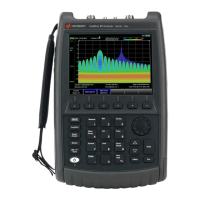88 Keysight N9938-90003 User’s Guide
Calibration for NA, CAT, and VVM Modes
See Also
Learn How to Make 75 ohm Measurements at the FieldFox Supplemental
Online Help:
http://na.support.keysight.com/fieldfox/help/SupHelp/FieldFox.htm
Why and When to Calibrate
There are well-defined and understood systematic errors that are measured
and calculated during the calibration process. These errors are caused by
leakage signals inside the FieldFox, by the frequency response of the FieldFox
receivers, and by reflections inside the FieldFox that interact with the DUT.
After calibration, these errors are removed from subsequent measurements.
To maintain highest measurement accuracy, perform a new calibration when
any of the following changes occur:
— When any of the following measurement settings change: Frequency
Range, Power Level, IF BW, and Resolution. Therefore, make these
measurement settings before calibrating. Increased Averaging, lower IF BW,
and higher Resolution all cause slower sweeps and slower calibration times.
Learn about Interpolation and Questionable Accuracy in “Interpolation *”
on page 103.
— When the FieldFox temperature changes more than about 10°F (5°C). Learn
more in “How to monitor the internal FieldFox temperature:” on page 22.
— When the connection to the DUT changes, requiring a different jumper
cable or adapter.
Definitions
DUT (Device Under Test) The cable, antenna, transmission line, amplifier, or
anything else that is connected to the FieldFox that is to be measured.
Calibration Standards - OPEN, SHORT, LOAD, and THRU
— OPEN, SHORT, and LOAD are ‘reflection’ standards that are used during
calibration. When an RF signal ‘hits’ these components, the signals are
reflected in a predictable manner. These components can also be used to
terminate a DUT port during some measurements.
— SHORT and OPEN standards both cause 100% of an RF signal to be
reflected. The difference between these two standards is what
happens to the phase of the reflected signal, which is beyond the

